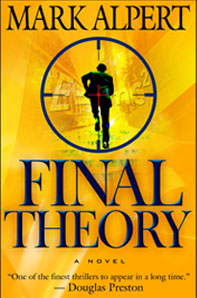Science thriller succeeds on many levels
 “Final Theory” succeeds on many levels as an outstanding thriller.
“Final Theory” succeeds on many levels as an outstanding thriller.
Scientific American magazine editor Mark Alpert’s first book avoids the sins of many modern thrillers that are too often too long and poorly plotted. Alpert’s novel engages the reader immediately with the search for a formula for a secret weapon and gives his readers a plot with unpredictable twists and turns.
Alpert creates an unusual hero in Columbia professor and science historian David Swift, who becomes embroiled in the search for the solution to a unified theory that will tie together quantum mechanics and Albert Einstein’s theory of relativity. Swift discovers that Einstein solved the unified theory and left clues to its solution with his old colleagues, who are being mysteriously killed.
Unfortunately for Swift, a renegade Russian, a turncoat FBI agent and the United States government are also in pursuit in the belief the theory will lead to a powerful weapon.
It’s refreshing that Muslim terrorists are not involved. Alpert’s villains are more like those created by Ian Fleming and other Cold War thriller writers, but Alpert gives the bad guys agendas that keep them from being cliches. Alpert is obviously no fan of the Draconian methods of the current administration and is particularly hard on the vice president of the United States, although he does not mention Dick Cheney by name.
Swift and his girlfriend, Princeton scientist Monique Reynolds, are involved in a series of clever escapes before the book’s climax at the Fermi National Accelerator Laboratory. The author, who started his college career as an astrophysics major but later became a poet, based some of the science in the book on a paper on two-dimensional physics that he co-wrote at Princeton. Without being too preachy, he explores the question, does the world need another doomsday weapon?









